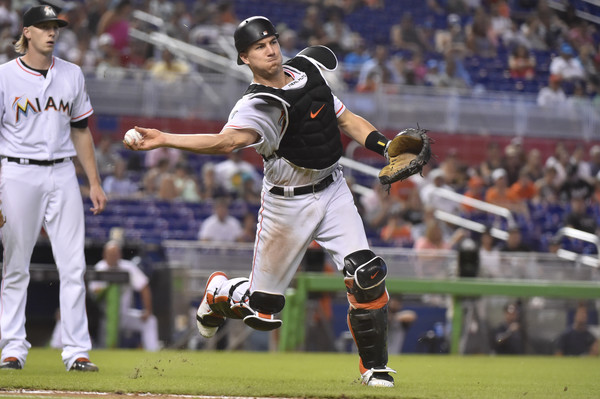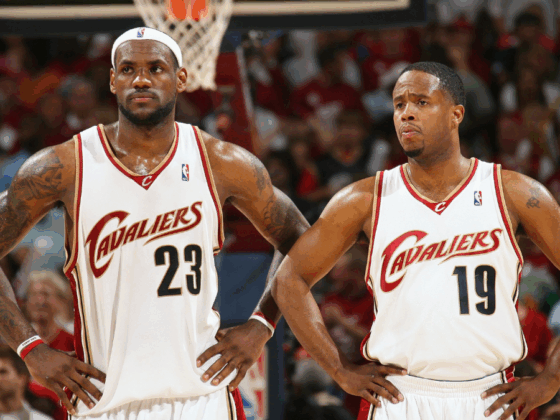
In the MLB, When you look at a catcher’s stats, the average fan is going to be drawn to the offensive stats such as average and on-base percentage, but that’s not really analyzing the value of a catcher. There are more offensive stats that you can look into, some of the more advanced statistics such as wOBA. This statistic basically combines all the different aspects of hitting into one number, because unlike average, wOBA does not consider all hits to be equal. Besides the offensive side of things, it is crucial to look at a catcher’s defensive abilities such as his receiving, blocking, and throwing.
To further analyze these numbers in the 2018 season,a spreadsheet was compiled containing the following info, innings, average, on-base percentage, CSAA, framing runs, EPAA, blocking runs, caught stealing percentage, throwing runs, and defensive runs-saved. That seems like a lot of information and some of those stats might be unclear so before looking into the data, let’s define the statistics and why they are important.
On the receiving side of the spectrum, CSAA is called strikes above-average is a statistic that is used to help determine catchers framing ability. CSAA measures the effect that a catcher has on a strike being called. CSAA goes hand in hand with framing runs, this statistic measures the number of runs that a catcher either gains or loses to a teams total based on their receiving ability.
For the blocking aspect of a catcher, there is a stat labeled EPAA which is errant pitches above average. EPAA measures the effect a catcher has on wild pitches and passed balls, essentially meaning the effectiveness of his blocking ability. Also under the blocking tab, there is blocking runs statistic which measures the number of runs a catcher gains or loses for his team based on his blocking ability.
For the throwing part of the table, caught stealing percentage is simply derived from the number of times a catcher was successful in throwing a runner out compared to the number of steal attempts against him. throwing runs are the measure of runs that a catcher gains or loses for his team based off of his throwing ability. Defensive runs saved comes from Fangraphs which is pretty self-explanatory, it is one statistic that takes into account the players entire defensive skillset and tells you how many runs were “saved” by the catcher.
This is not to point out that there is a flaw within the table when you look at column L (in Figure 1 below), there is a discrepancy in numbers because it is weighing receiving, blocking, and throwing the same when calculating the net gain or loss. A lot of time was spent trying to figure out the best way to weight these, and a good formula that worked out that weighted these factors could not be done without having to do months and months of research. However, even without a weighted category, the spreadsheet still shows you the catchers overall defense and how it factored into his team’s success. The flaw can be seen when you compare framing runs, blocking runs, and throwing runs to a players overall defensive runs saved (DRS) score because for calculating DRS they are weighted so even if players have a high number in say framing runs but a negative number for blocking runs they could still have a high DRS because framing runs are most likely being weighted higher.
Also, it is important to note that the criteria/qualifier for catchers included in this Figure of statistics was that the catcher had to catch in 700 innings during the 2018 season.

After looking at this data, there was one thing that stuck out to me, before I analyzed each of the individual aspects of offense, throwing, blocking, and receiving. Coming into this, one would be under the impression that Jonathan Lucroy was a very good defender and was a pretty good help to the Athletics defensive success, this spreadsheet pretty much speaks to the opposite. Looking at Lucroy, he is losing almost four runs in framing and blocking. His caught stealing percentage was at 30.1% which put him in the middle of the pack for this sample size. But the one thing that really stuck out to me was Lucroy’s DRS rating being -11, which would deliver the impression that Lucroy’s defense was one of his strong suits and this research almost showed that this year he definitely struggled.
Offensively the common names in the top grouping for average and on-base percentage were Wilson Ramos, Buster Posey, J.T. Realmuto, Francisco Cervelli, and Yasmani Grandal. There is a lot of value offensively in a catcher who can hit better than .250, looking only at offense a catcher who hits above .250 is a good fit for any given team. For example, Willson Contreras hit .249 last year, but he also hit 10 home runs with 54 RBI’s he was not power hitting monster but he still provided an almost .250 average and drove runs in. A catcher’s offensive value can be overshadowed by the defense as we’ll see below, look at the case of Mike Zunino who hit .201 but still had some very good defensive contributions which can almost make up and overshadow his offensive struggling.
The claim regarding receiving would be simple, a catchers framing is the most important aspect of his game, and has the largest impact on his DRS and overall defensive game. The ability to have more called strikes will lead to quick outs which in turn makes your pitcher throw fewer pitches allowing for less chance to make an error and miss his spot giving up a hit.
The top five leaders in CSAA were…
1. Hedges, Austin
2. Grandal, Yasmani
3. Alfaro, Jorge
4. Posey, Buster
T-5. Gomes, Yan
T-5. Zunino, Mike
The top five leaders in Framing runs were…
1. Grandal, Yasmani
2. Hedges, Austin
3. Alfaro, Jorge
T-4. Gomes, Yan
T-4. Zunino, Mike
5. Maldonaldo, Martin
Essentially, it would remain true that the higher players in CSAA are in the higher numbers on framing runs. This logic makes a lot of sense when it basically says, the more strikes called above average that a catcher gets, then the more amount of runs a catcher is helping save his team. In the case for Austin Hedges, however, he was not too high on the offensive totals which really shows that someone’s defense can overshadow his offensive output with his defense which he tied for first in this sample size for DRS.
On the other side of framing, there are players who are not the greatest at framing. For example, there’s Robinson Chirinos who lost the Rangers about 11 runs this year and has a DRS rating of -11 which really overall shows how his framing can hinder his ability to contribute runs based on his defense. There is also Willson Contreras who ranked the worst in CSAA and framing runs, losing almost 18 runs on framing alone for the Cubs, however, his DRS was still a gain of 2 runs for the Cubs which is because of his throwing ability, but it could have been much higher but because of his lack of framing ability that number was only at two.

The next aspect of a catchers defense I looked at was blocking, the ability to keep the ball in front of you is something all catchers know is crucial. In MLB, the difference between a passed ball and a blocked ball could mean putting a runner into scoring position which no catcher wants to be responsible for.
The top five leaders in Blocking Runs were…
1. Barnhart, Tucker
2. Contreras, Willson
3. Gomes, Yan
4. Suzuki, Kurt
T-5. Molina, Yadier
T-5. Pina, Manny
To revisit the case of Contreras discussed above, it was easy to see how his lack of framing ability hindered his DRS rating from being higher. He was second in blocking runs saving almost two runs just simply based on his blocking ability which would make sense why his DRS rating is not severely negative because of his high ranking in blocking ability.
Next, take a look at how Tucker Barnhart’s numbers in blocking and framing affected his total DRS rating. Barnhart had a total loss of almost 12 runs on the receiving aspect, but his blocking was the highest saving three runs, so again just like Contreras you can see why his DRS rating was saving 5 runs. Barnhart’s value to the Reds comes in his ability block the ball, keeping it in front of him, which can keep pitchers from surrendering more runs.

The final tool or aspect of a catchers defense to look at was throwing, the ability of a catcher to throw runners out on the basepaths which is crucial in stopping players from advancing which in turn stops runners from getting into scoring position.
The top five in caught stealing percentage were…
1. Maldonaldo, Martin
2. Perez, Salvador
3. Pina, Manny
4. Cervelli, Francisco
5. Realmuto, JT
The top five in Throwing Runs were…
1. McCann, James
2. Perez, Salvador
3. Cervelli, Francisco
T-4. Pina, Manny
T-4. Maldonaldo, Martin
T-5. Contreras, Willson
T-5. Zunino, Mike
Looking at the Contreras situation again, you can see how a highly negative framing runs, but with positive blocking and throwing runs can still come together to produce a positive DRS number. This shows that with different weights, it’s going to affect the catcher’s DRS in different ways, so having negative numbers may not always indicate that a catcher is bad, since Contreras produces offensively and just because of framing does not mean that he is absolute garbage and needs to be replaced, it just means that his framing needs to be worked on.
Salvador Perez was second in both categories for this aspect and was also the American Leagues Gold Glove Winner for best defensive catcher. However, his blocking and receiving numbers were in the lower portions for both being in the lowest 30% or worse for blocking and receiving. This stumped me, how can a catcher who had bad blocking and receiving number win an award for the BEST defense in the American League. It brings up the curiosity about knowing the exact qualifications and criteria for picking the Gold Gloves.
So overall, based on the statistics that were presented in Figure 1, you can determine a catcher’s defense needs to be valued much higher than simply just his offense alone. Otherwise, players like Austin Hedges and Mike Zunino are going to be worth nothing compared to players like Wilson Ramos who have great offensive outputs. Ultimately, it would be best to be able to get a catcher who is able to produce a decent offensive output while also being able to efficiently perform in the three aspects discussed above.
Besides the individual statistics that were in Figure 1, you also have to look at the effects of a catchers defense on all ten of the 2018 Playoffs teams from a team aspect. For this chart, any catcher who played on the MLB playoff teams who caught more than 15 games during the 2018 regular season was considered.

The interesting thing about these team numbers was that the Dodgers and Red Sox had the highest total gain or loss of totals, and they were in the World Series. Understandably, these categories are not weighted as stated above, so its simply just adding the three aspects together but it is interesting that the two teams who played each other in the World Series had the best defensive catchers out of the ten teams who were in the playoffs. Just as interesting, the two teams who made it to the wildcard games but lost had the lowest and also negative totals for their respective catchers.
In terms of DRS, it is quite interesting to me to see the Dodgers, Brewers, and Yankees as the top three teams. Its evident that the success of these teams, could definitely be helped out by the defense of their catchers. It is almost as if having a good catcher is going to not only help your team prevent more runs but be able to win more ballgames as a club. Now I do not want to be confused as stating that catching alone produces wins, but there is a definite correlation, based on the statistics presented that catchers who are effective at what they do defensively are going to HELP produce more wins. This does not mean that catchers with good defense are producing wins by themselves, however, they are contributing on both sides of the baseball, and they are taking runs away from the opposing team simply based on their effectiveness in their defense.






